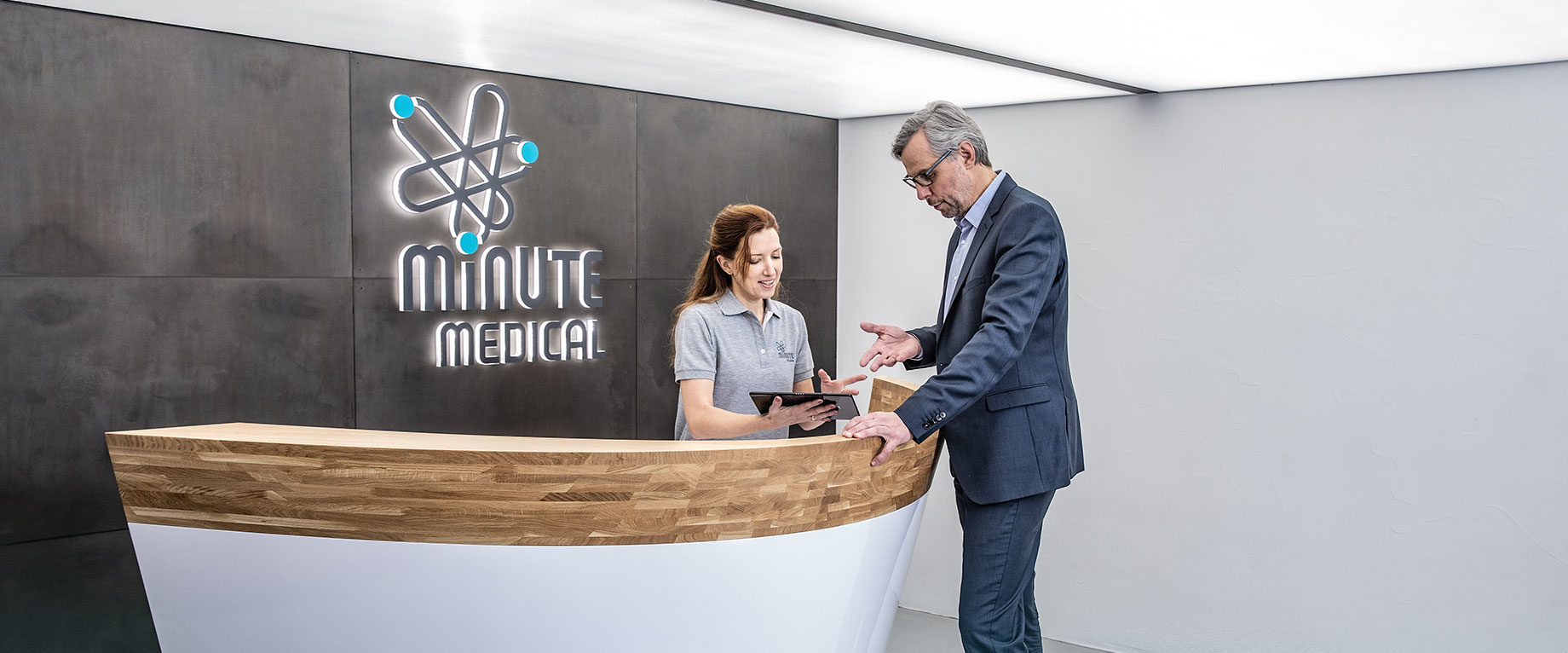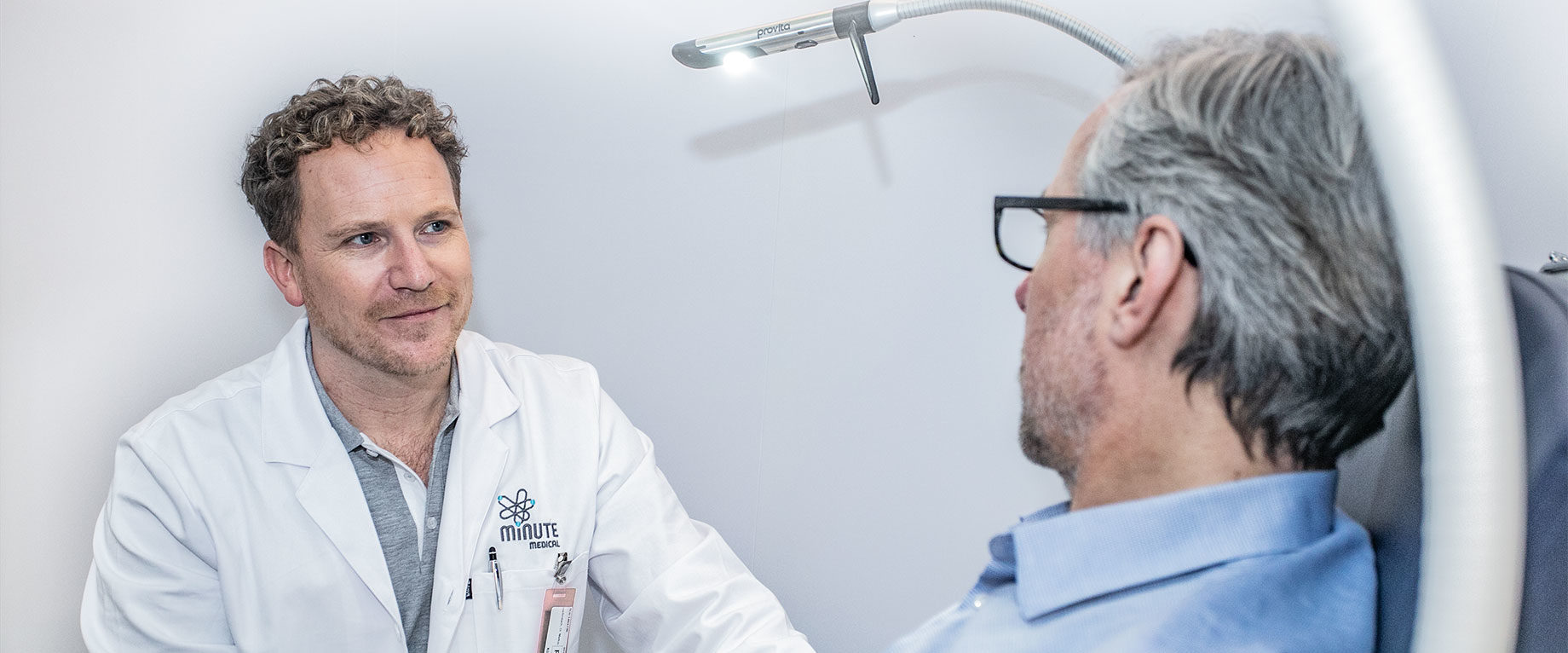Interview with Prof. Haug, conducted by Primo Medico on 09 July 2025
Primo Medico Specialist Talk, the Specialists’ Podcast with Susanne Amrhein — “Medicine for the Ears”
(Audio in English is AI-generated. The original in German.)
Neuroendocrine cells are responsible for producing various hormones and are found almost everywhere in the body. Unfortunately, these cells can also develop into tumors. Such neuroendocrine tumors are rare and can take on very different subtypes, which can make treatment challenging. One option within the field of so-called theranostics is peptide receptor radionuclide therapy, or PRRT for short. I’m speaking with Professor Alexander Haug about how it works and why it is so effective. He is a specialist in nuclear medicine at Minute Medical in Vienna.
- [00:42] What exactly is peptide receptor radionuclide therapy?
- [01:54] For which types of tumors is PRRT particularly suitable?
- [03:09] How can neuroendocrine tumors be detected or confirmed, specifically whether the required receptors are present?
- [04:33] Under what conditions is peptide receptor radionuclide therapy considered appropriate?
- [05:42] How does peptide receptor radionuclide therapy work for the patients?
- [07:15] What side effects can occur with this treatment?
- [08:23] How successful is the therapy?
- [09:32] Can peptide receptor radionuclide therapy be repeated if there is a recurrence?
- [10:32] Do health insurance providers cover the cost of the treatment?
Primo Medico (PM): Professor Haug, perhaps you could start by explaining: What exactly is peptide receptor radionuclide therapy?
Prof. Alexander Haug (AH): Peptide receptor radionuclide therapy, or PRRT for short, is an innovative form of cancer treatment — especially for certain types of tumors, such as the mentioned neuroendocrine tumors. Imagine sending a kind of targeted medication directly to the tumor cell. This medication consists of a small protein building block, known as a peptide, which binds specifically to certain receptors on the surface of tumor cells. We couple this peptide with a radioactive emitter — essentially a mini-radiation unit. What makes it special is that the radiation is delivered directly into the tumor cell, from the inside out, rather than from the outside in, as with conventional radiation through the skin. The surrounding healthy tissue is largely spared, because the range of this radiation is very limited. The goal of the therapy is to shrink the tumor — and especially its metastases — to stop its growth, and thereby significantly relieve the patients’ symptoms. For many patients, especially those with advanced tumors where other treatments are no longer effective, PRRT can be a very effective and gentle option — offering new hope.
PM: I already alluded to the fact that there are many subtypes or different forms of neuroendocrine tumors. For which types of tumors is PRRT particularly suitable?
AH: PRRT is primarily suitable for so-called neuroendocrine tumors, also known as NETs for short. These are special types of tumors that develop from cells of the hormone-producing system. These cells are found in many parts of the body, which is why neuroendocrine tumors can arise in a wide variety of organs. Most commonly, we find them in the gastrointestinal tract — for example, in the small intestine, rectum, or pancreas. But they can also occur in the lungs or other organs.
Neuroendocrine tumors vary greatly. Some grow very slowly and remain undetected for a long time because they initially cause hardly any symptoms. Others are significantly more aggressive and grow faster. Sometimes they form metastases in the liver or lymph nodes.
What many of these tumors have in common is that they carry certain receptors on their surface — the so-called somatostatin receptors. And this is exactly what PRRT takes advantage of. The treatment only works if these receptors are present. That’s why we examine very carefully whether the tumor displays these target structures. If it does, PRRT can be a highly targeted and effective treatment — especially when other therapies, such as surgery, chemotherapy, or external radiation, are no longer sufficient or not an option at all.
PM: How can neuroendocrine tumors be detected or confirmed, specifically whether the required receptors are present?
AH: Yes, that is, of course, a very important question. The earlier we detect a tumor, the more targeted our treatment can be. The so-called gold standard — the best and most accurate method for diagnosing neuroendocrine tumors today - is the PET-CT scan, using a special substance that binds specifically to the somatostatin receptors on the tumor cells. You can think of it this way: we give the patient a slightly radioactive labeled medication intravenously, which then travels through the body to where tumor cells with these receptors are located. The PET-CT camera then shows us very precisely where these cells are present, even when the tumors are still very small.
This examination is important not only for diagnosis but also for therapy. This is where a modern concept called theranostics comes into play. The word combines therapy and diagnostics. The principle is that we use the same key — the same molecule that docks onto a tumor cell — first with a radiodiagnostic isotope to detect the tumor via PET-CT, and then with a therapeutic radioisotope to target and irradiate the cells precisely with PRRT. This means that diagnosis and therapy are perfectly coordinated. We see exactly where the tumor cells are located and then treat them right there. This makes the treatment not only more precise but often also more successful and gentler for the patient.
PM: You mentioned earlier that many patients have already undergone several therapies that did not provide sufficient benefit. Under what conditions is peptide receptor radionuclide therapy considered appropriate?
AH: PRRT is, of course, not suitable for all patients, but it becomes an option when certain conditions are met. This therapy works best for slow-growing neuroendocrine tumors that carry those somatostatin receptors on their surface. As I mentioned, we carefully verify this beforehand using a special PET-CT scan.
Furthermore, PRRT is often a very good option when the tumor can no longer be surgically removed— for example, because it has already formed metastases or is located in a difficult-to-access area. Even when other treatments, such as chemotherapy and medications, are not sufficiently effective, PRRT can be a valuable alternative to slow tumor growth, relieve symptoms, and improve quality of life. It is very important that the therapy is always individually planned, depending on the tumor type, stage, and the patient’s overall condition. But when the conditions are right, PRRT is a highly targeted, gentle, and often very effective form of treatment.
PM: Could you explain once more how the process works? Specifically, how does peptide receptor radionuclide therapy work for the patients?
AH: PRRT is a very targeted form of cancer therapy. It is based on radioligands — that is, radioactively labeled molecules that bind very specifically to the tumor cell. In practice, we use a special medication, most commonly Lutetium-177 Dotatate. This is a small protein fragment that attaches to the somatostatin receptors on the tumor cell and delivers a radioactive substance directly into the tumor cell. You can think of it as a tiny, precise radiation courier that exerts its effect exactly where the tumor is located.
The procedure goes like this: the patient receives the radioligand via an intravenous infusion. The substance distributes throughout the body and binds where the appropriate receptors are present — ideally, only on the tumor cells. There, the radioligand emits targeted radiation that damages and destroys the tumor cells without significantly harming healthy tissue.
The therapy follows a strict protocol, but it is individually tailored to each patient. We carefully consider the tumor type, its distribution, the patient’s overall health, and also how well the kidneys and bone marrow are functioning, since these organs need to be protected.
Usually, PRRT is administered in several cycles spaced about eight weeks apart to achieve optimal effectiveness and avoid overburdening the body.
In summary, it is a very precise, highly specialized form of therapy that shows very good results, especially in advanced, slow-growing neuroendocrine tumors.
PM: What side effects can occur with this treatment?
AH: Like any therapy, PRRT can also have side effects. Overall — and this is especially important to me — it is comparatively well tolerated, especially when compared to conventional chemotherapy. The radiation acts very specifically on the tumor cells. Nevertheless, healthy cells, particularly in the kidneys and bone marrow, can also be somewhat affected. That’s why we protect the kidneys during treatment with a special infusion and regularly monitor blood counts.
Possible side effects may include nausea or mild discomfort on the day of treatment, but this is usually well manageable. Fatigue or tiredness in the days following therapy is reported by many patients but often resolves quickly. In rare cases, blood counts may temporarily drop — for example, white blood cells or platelets — which is why we monitor patients closely. Long-term, the risk of serious complications is low. Of course, every patient is cared for individually, and the therapy is adjusted accordingly.
The goal is always to achieve maximum effect against the tumor with minimal strain on the body. And that is exactly what makes PRRT a very well-tolerated treatment option for many patients.
PM: Every person diagnosed with cancer wishes for it to disappear. How successful is the therapy?
AH: The successes we see with PRRT are truly impressive, especially in patients with advanced and slow-growing neuroendocrine tumors. Patients benefit from PRRT on several levels. The tumor shrinks and grows more slowly. Metastases can be pushed back. Symptoms lessen, particularly hormone-related symptoms or pain. And very importantly, quality of life improves significantly through the therapy. This has also been demonstrated in several studies.
Studies have shown that PRRT can double progression-free survival — that is, the time during which the tumor no longer grows. The overall survival time can also be extended for some patients.
Of course, every situation is individual. We cannot promise that the tumor will disappear. But in practice, we often see patients remaining stable for years or feeling noticeably better. For many, this means a significant gain in both lifespan and quality of life. Precisely because the therapy acts so targeted and gently, it is a very valuable option for many patients, often after they have already experienced a long course of illness.
PM: If there is a recurrence—that is, a return or flare-up of the cancer—can peptide receptor radionuclide therapy be repeated if needed?
AH: Yes, that is indeed possible. In many cases, PRRT can be repeated in the event of a recurrence of the disease—what we call a retreatment or repeat course of PRRT. This is especially useful when the initial treatment was effective and the tumor becomes active again after some time.
Of course, we must carefully assess how aggressively the tumor has returned and what the patient’s general condition is—above all, whether the kidneys and bone marrow tolerated the first therapy well. If all of that is in order, a repeat treatment can help control tumor growth again and relieve symptoms—often with a similarly good level of tolerability as the first course.
The key point is that PRRT is not a one-time option, but can, under certain conditions, become part of a long-term, comprehensive treatment plan. This allows us to adapt the therapy to the course of the disease and give our patients new prospects—even in the event of a relapse.
PM: Do health insurance providers actually cover the cost of the treatment?
AH: That’s an important question, because of course, cost coverage plays a major role in any treatment. In our case, PRRT is offered as a private service. This means the treatment is carried out in a private facility and is not automatically covered by all statutory health insurance providers. Private health insurance companies, on the other hand, often cover the costs, either fully or partially—especially when the medical necessity is clearly established. We clarify that in detail with you beforehand and also help with communication with the insurance provider.
For patients with statutory insurance, there is—in certain circumstances—the possibility to apply for reimbursement. However, this is always decided on a case-by-case basis, with the health insurance provider reviewing whether the treatment is medically justified and not otherwise available. It’s best to discuss this early on so we can look together at what’s possible and what the next steps might be for you.
PM: Thank you very much for the information, Professor Haug.






